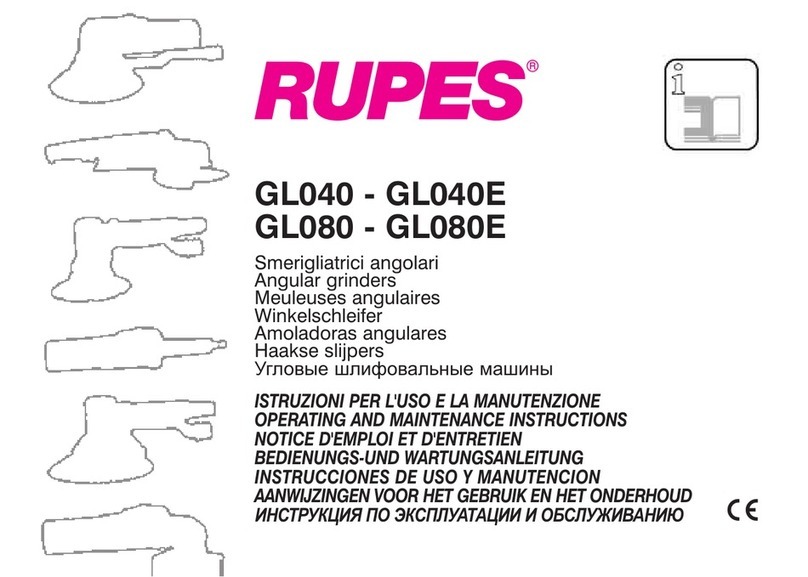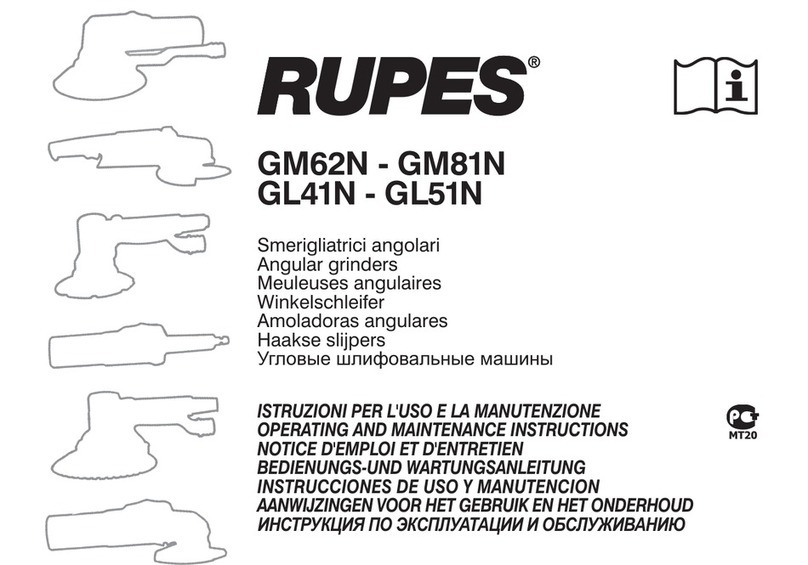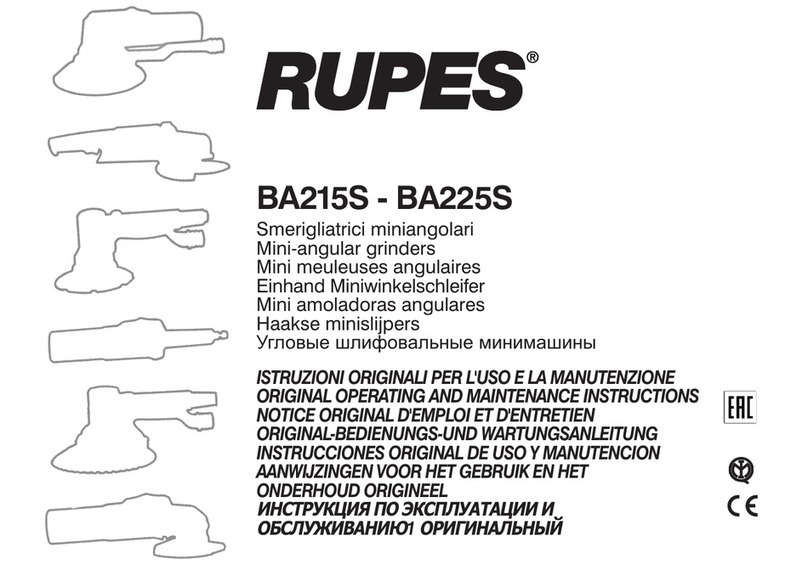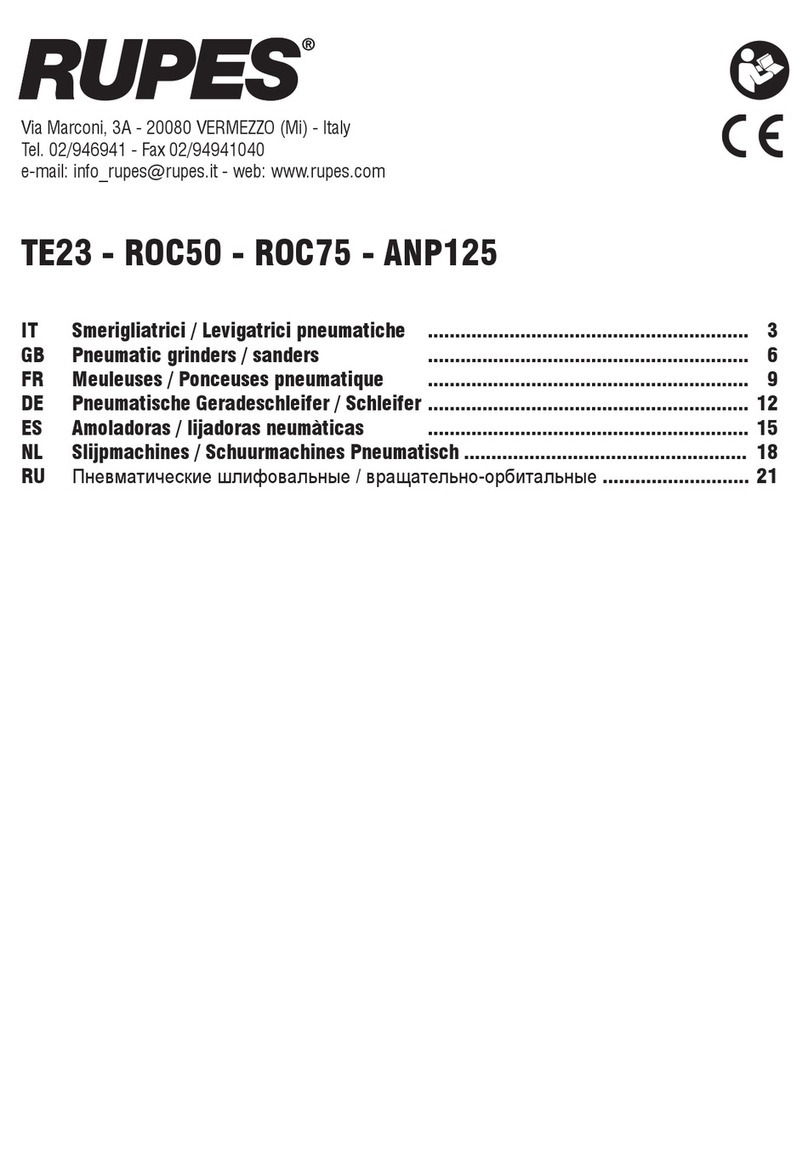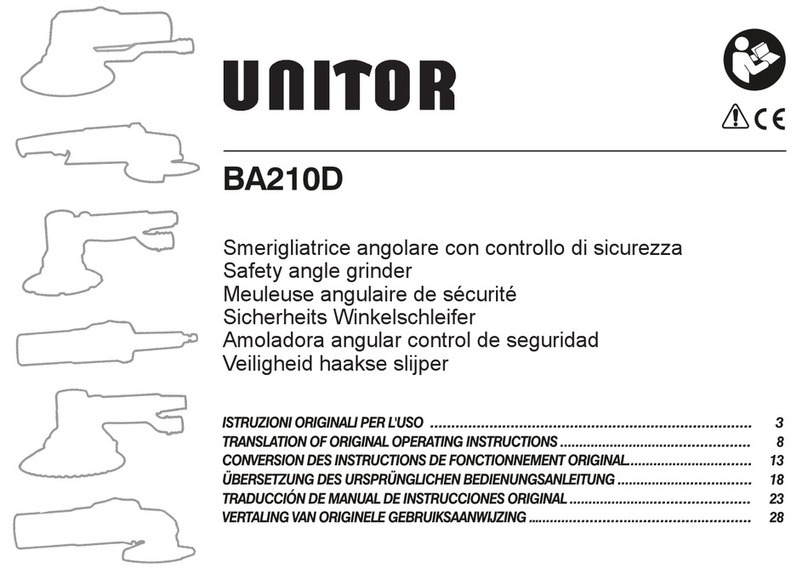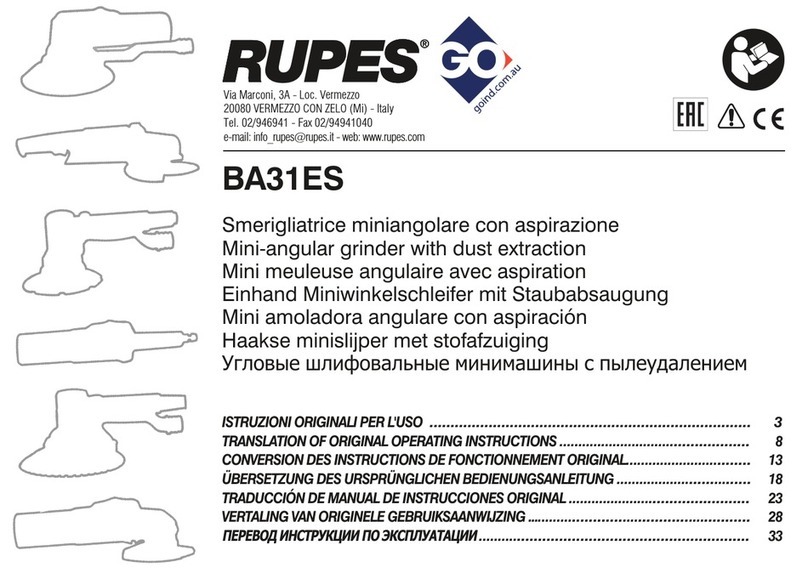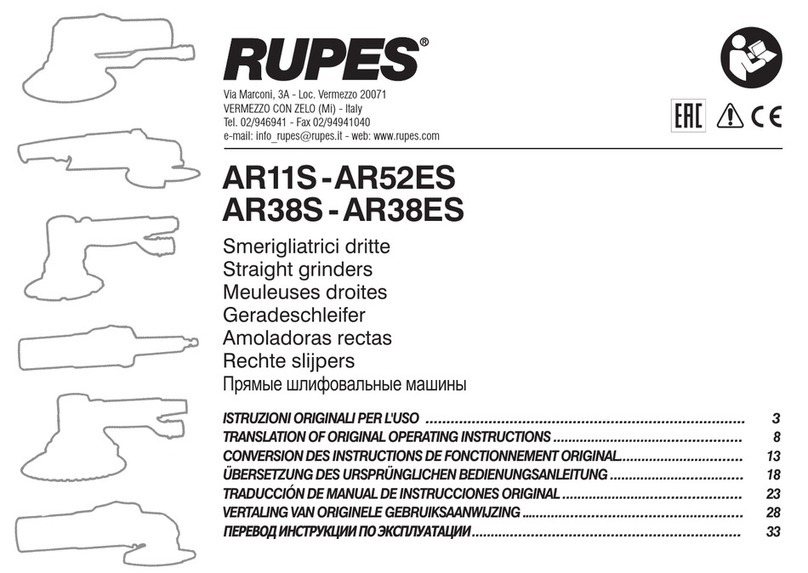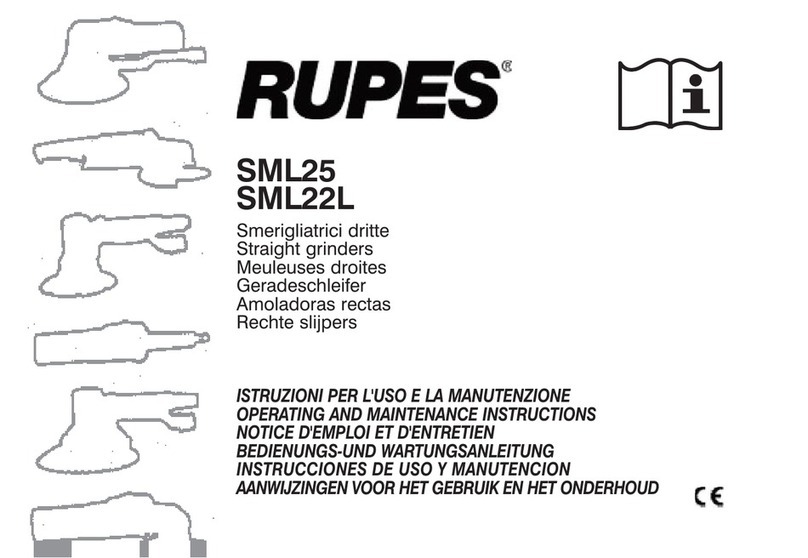
5
vicinanze della zona di lavoro.
Tenere l’utensile unicamente per le superfici di presa isolanti, mentre si
effettuano le operazioni in cui l’accessorio di taglio può essere in contatto
con dei cavi nascosti oppure con il suo stesso cavo. Il contatto tra
l’accessorio di taglio con un cavo “in tensione” può ugualmente mettere “in
tensione” le parti metalliche esposte dell’utensileelettrico e far prendere una
scossa elettrica all’operatore.
Posizionare il cavo lontano dall’accessorio di rotazione. Se perdete il
controllo, il cavo può essere tagliato oppure attorcigliarsi e la vostra mano
oppure il braccio può essere tirato nell’accessorio di rotazione.
Non riporre mai l’utensile elettrico prima che l’accessorio non si sia fermato
completamente. L’accessorio di rotazione può fare presa sulla superficie e
mettere l’utensile elettrico fuori del vostro controllo.
Non fare funzionare l’utensile elettrico mentre lo si porta a fianco.
Un contatto accidentale con l’accessorio di rotazione potrebbe far impigliare i
vostri vestiti e attirare l’accessorio addosso a voi.
Pulire con regolarità le aperture di ventilazione dell’utensile elettrico. Il
ventilatore del motore attirerà la povere all’interno dell’alloggiamento e un
accumulo eccessivo di polvere di metallo può provocare dei pericoli elettrici.
Non far funzionare l’utensile elettrico in prossimità di materiali infiammabili.
Le scintille potrebbero infiammare questi materiali.
Non utilizzare degli accessori che hanno bisogno di refrigeranti liquidi.
L’utilizzo di acqua o di altri refrigeranti liquidi può provocare un’elettrocuzione o
una scossa elettrica.
AVVERTIMENTI DI SICUREZZA AGGIUNTIVE PER LE OPERAZIONI DI
MOLATURA E DI TAGLIO ABRASIVO
Utilizzare unicamente tipi di mola consigliati per il vostro utensile e la
protezione specifica concepita per la mola scelta. Le mole per le quali non è
stato concepito l’utensile non possono essere protette in modo
soddisfacente e non sono sicure.
La protezione deve essere solidamente fissata all’utensile e messa in
posizione di sicurezza massima, di modo che l’operatore sia esposto il
meno possibile alla mola. La protezione permette di proteggere l’operatore dai
frammenti di mola rotta e da un contatto accidentale con la mola.
Le mole devono essere utilizzate solo per le applicazioni raccomandate.
Per esempio: non smerigliare con il lato della mola da taglio. Le mole
abrasive da taglio sono destinate alla molatura periferica, l’applicazione di forze
laterali a queste mole può farle rompere.
Usare sempre flange per mola non danneggiate e che siano di dimensione
e forma corrette per la mola che avete scelto. Le flange per mola appropriate
sorreggono la mola, riducendo così la possibilità di rottura della mola. Le flange
per mole da taglio possono essere diverse dalle flange per mola da
smerigliatura.
Non utilizzare mole usate di utensili più grandi. La mola destinata a un
utensile più grande non è adatta a causa delle velocità più elevata di un
utensile più piccolo: la mola può esplodere.
AVVERTIMENTI DI SICUREZZA AGGIUNTIVE PER LE OPERAZIONI DI
TAGLIO ABRASIVO
Non “mandare in blocco” la mola da taglio né applicare una pressione
eccessiva. Non tentare di rendere il taglio eccessivamente profondo. Una forte
pressione sulla mola aumenta il carico e la probabilità di torsione o di
piegamento della mola nel taglio e la possibilità di contraccolpo o di rottura della
mola.
Non mettetevi allineati alla mola in rotazione, neppure dietro di essa. Quando
la mola, nel momento in cui funziona, si allontana dal vostro corpo, l’eventuale
contraccolpo può spingere la mola in rotazione, insieme all’utensile, direttamente
verso di voi.
Quando la mola si piega o quando si interrompe il taglio per una qualsiasi
ragione, staccare l’utensile dall’alimentazione e tenerlo immobile sino a che
la mola non si sia completamente fermata. Non cercare mai di togliere la mola
da taglio mentre la mola è in movimento altrimenti potrebbe verificarsi un
contraccolpo.Bisogna risalire alle cause del piegamento della mola e prendere
le misure correttive affinché non si verifichi più.
Non riprendere l’operazione di taglio nel pezzo in lavorazione. Lasciare che
la mola raggiunga la sua velocità piena e rientrare con attenzione nel taglio.
La mola si può bloccare, risalire oppure avere un contraccolpo se l’utensile viene
riavviato nel pezzo in lavorazione.
Prevedere un supporto per i pannelli o per qualsiasi pezzo di grosse
dimensioni in lavorazione per ridurre al minimo il rischio di incastro e di
contraccolpo della mola. I pezzi in lavorazione grandi hanno la tendenza a
flettersi sotto il loro stesso peso. I supporti devono essere messi sotto il pezzo in
lavorazione, vicino alla linea di taglio e vicino al bordo del pezzo in lavorazione
su entrambi i lati della mola.
Siate particolarmente prudenti quando fate un “taglio a tasca” in pareti
esistenti o in altre zone senza visibilità. La mola sporgente può tagliare tubi
del gas o dell’acqua, cavi elettrici o oggetti causando possibili contraccolpi.
AVVERTIMENTI DI SICUREZZA SPECIFICI PER LE OPERAZIONI DI
SPAZZOLATURA METALLICA:
Tener presente che la spazzola, anche nel corso del funzionamento
ordinario, emette delle setole metalliche. Non applicare troppa forza ai fili
metallici applicando un carico eccessivo alla spazzola. Le setole metalliche
possono facilmente penetrare nei vestiti leggeri e/o nella pelle.
Se è consigliato l’utilizzo di una protezione per la spazzolatura metallica,
non consentire alcuna interferenza del disco a fili metallici o della spazzola
con la protezione. Il disco a fili metallici o la spazzola possono dilatarsi in
diametro a causa del carico di lavoro e delle forze centrifughe.
ULTERIORI AVVERTENZE DI PERICOLO
Evitare accumuli di polvere sul posto di lavoro. Le polveri si possono
incendiare facilmente.
Un pezzo in lavorazione può essere bloccato con sicurezza in posizione solo
utilizzando un apposito dispositivo di serraggio oppure una morsa a vite e
non tenendolo con la semplice mano. Regolare la cuffia di protezione in
modo tale da impedire una scia di scintille in direzione dell’operatore.
Non toccare mole abrasive da sgrosso e taglio prima che le stesse si siano
raffreddate. Azionare il tasto di bloccaggio dell’alberino solo ed
esclusivamente quando l’alberino e fermo.
In caso contrario l’utensile elettrico potrebbe subire dei danni.
Indossare gli occhiali protettivi






